| Reptiles Fossil range: Carboniferous - Recent | |
|---|---|
 Petrolacosaurus kansensis, a primitive, diapsid from the Late Carboniferous of Kansas, and one of the earliest known reptiles. | |
| Scientific classification
| |
|
See text. | |
Reptiles, or members of the class Reptilia, are air-breathing, cold-blooded vertebrates that have skin covered in scales as opposed to hair or feathers. They are tetrapods (having or having descended from vertebrates with four limbs) and amniotes, whose embryos are surrounded by an amniotic membrane.
The majority of reptile species are oviparous (egg-laying) although certain species of squamates are capable of giving live birth. This is achieved, either through ovoviviparity (egg retention), or viviparity (offspring born without use of calcified eggs). Many of the viviparous species feed their fetuses through various forms of placenta analogous to those of mammals with some providing initial care for their hatchlings.
Classification[]
History of classification[]
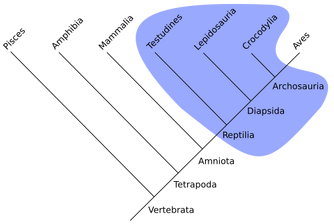
Reptiles are a paraphyletic group. If birds were included would it be monophyletic.
From the classical standpoint, reptiles included all the amniotes except birds and mammals. Thus reptiles were defined as the set of animals that includes crocodiles, alligators, tuatara, lizards, snakes, amphisbaenians, and turtles, grouped together as the class Reptilia (Latin repere, "to creep"). This is still the usual definition of the term. However, in recent years, many taxonomists have begun to insist that taxa should be monophyletic, that is, groups should include all descendants of a particular form. The reptiles as defined above would be paraphyletic, since they exclude both birds and mammals, although these also developed from the original reptile.
The terms "Sauropsida" ("Lizard Faces") and "Theropsida" ("Beast Faces") were coined in 1916 by E.S. Goodrich to distinguish between lizards, birds, and their relatives on one hand (Sauropsida) and mammals and their extinct relatives (Theropsida) on the other. Goodrich supported this division by the nature of the hearts and blood vessels in each group, and other features such as the structure of the forebrain. According to Goodrich, both lineages evolved from an earlier stem group, the Protosauria ("First Lizards") which included some Paleozoic amphibians as well as early reptiles.[1]
In 1956 D.M.S. Watson observed that the first two groups diverged very early in reptilian history, and so he divided Goodrich's Protosauria among them. He also reinterpreted the Sauropsida and Theropsida to exclude birds and mammals respectively. Thus his Sauropsida included Procolophonia, Eosuchia, Millerosauria, Chelonia (turtles), Squamata (lizards and snakes), Rhynchocephalia, Crocodilia, "thecodonts" (paraphyletic basal Archosauria), non-avian dinosaurs, pterosaurs, ichthyosaurs, and sauropyterygians.[2]
This classification supplemented, but was never as popular as, the classification of the reptiles (according to Romer's classic Vertebrate Paleontology[3]) into four subclasses according to the positioning of temporal fenestrae, openings in the sides of the skull behind the eyes. Those divisions were:
- Anapsida – no fenestrae
- Synapsida – one low fenestra (now in Dinosauria)
- Euryapsida – one high fenestra (now included within Diapsida)
- Diapsida – two fenestrae
- Dinosauria
All of the above fall under Sauropsida.
Taxonomy[]
Classification to order level, after Benton, 2004.[4]

Qianosuchus mixtus, an archosaur from the Middle Triassic of China

Hypothetical reconstruction of Dromomeron romeri, a dinosauriform from the Late Triassic of New Mexico

Doswellia kaltenbachi, an archosaur from the Upper Triassic of North America

Euparkeria capensis, from the Early Triassic of South Africa

Gracilisuchus stipanicorum, a tiny genus of crurotarsan from the Middle Triassic of Argentina.
- Series Amniota
- Reptiles
- Class Dinosauria
- Class Synapsida
- Order Pelycosauria*
- Order Therapsida
- Class Synapsida
- Class Reptilia
- Subclass Anapsida
- Order Testudines (turtles)
- Subclass Diapsida
- Order Araeoscelidia
- Order Younginiformes
- Infraclass Ichthyosauria
- Infraclass Lepidosauromorpha
- Superorder Sauropterygia
- Order Placodontia
- Order Nothosauroidea
- Order Plesiosauria
- Superorder Lepidosauria
- Order Sphenodontia (tuatara)
- Order Squamata (lizards & snakes)
- Superorder Sauropterygia
- Infraclass Archosauromorpha
- Order Prolacertiformes
- Division Archosauria
- Subdivision Crurotarsi
- Superorder Crocodylomorpha
- Order Crocodilia
- Order Phytosauria
- Order Rauisuchia
- Order Rynchosauria
- Superorder Crocodylomorpha
- Subdivision Avemetatarsalia
- Infradivision Ornithodira
- Order Pterosauria
- Superorder Dinosauria
- Order Saurischia
- Class Aves
- Order Ornithischia
- Order Saurischia
- Infradivision Ornithodira
- Subdivision Crurotarsi
- Subclass Anapsida
- Class Reptilia
Evolution[]
Rise of the reptiles[]
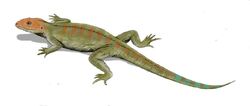
The early reptile Hylonomus

Edaphosaurus boanerges fossil skeleton on display in Harvard Museum of Natural History
Hylonomus is the oldest-known reptile in the biological sense, and was about 8 to 12 inches (20 to 30 cm) long. Westlothiana has been suggested as the oldest reptile, but is for the moment considered to be more related to amphibians than amniotes. Petrolacosaurus and Mesosaurus are other examples. The earliest reptiles were found in the swamp forests of the Carboniferous, but were largely overshadowed by bigger labyrinthodont amphibians such as Proterogynrius. It was only after the small ice age at the end of the Carboniferous that the reptiles grew to big sizes, producing species such as Edaphosaurus and Dimetrodon.
Anapsids, synapsids and sauropsids[]
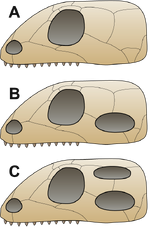
A = Anapsid, B = Synapsid, C = Diapsid
The first reptiles are categorized as Synapsids, having a solid skull with holes only for nose, eyes, spinal cord, etc.[5] Turtles are believed by some to be surviving Anapsids, as they also share this skull structure, but this point has become contentious lately, with some arguing that turtles reverted to this primitive state in order to improve their armor.[6] Both sides have strong evidence, and the conflict has yet to be resolved.
Some 20 to 25 million years after the first reptiles appeared, two branches split off. One lead to the Synapsida (the "mammal-like reptiles" or "stem mammals"), having two openings in the skull roof behind the eyes high , the other group, Diapsida, possessed a pair of holes in their skulls behind the eyes, along with a second pair located higher on the skull. The function of the holes in bout groups was to lighten the skull and give room for the jaw muscles to move, allowing for a more powerful bite.[7] The primitive Anapsida, which did not develop holes in their skulls continued and flourished throughout the Paleozoic, eventually disappearing at the close of the Permian (the turtles being possible survivors).[8] The diapsids and later anapsids are classed as the "true reptiles", the Sauropsida.[1]
Reptiles in the Mesozoic[]
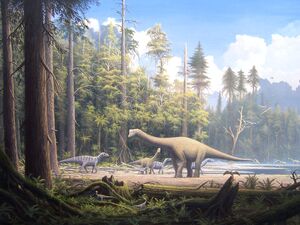
Mesozoic scene showing typical reptilian megafauna, the dinosaurs Europasaurus holgeri and Iguanodon, the bird-like dinosaur Archaeopteryx perched on the treestump.
Well before the Mesozoic, the Diapsida split again into two lineages, the lepidosaurs (which contain modern snakes, lizards, and tuataras, as well as, debatably, the extinct sea reptiles of the Mesozoic) and the archosaurs. The early archosaurs was characterized by elongated hind-legs and an erect pose, and looked somewhat like long legged crocodiles. The archosaurs became the dominant group during the Triassic, developing into the well known dinosaurs and pterosaurs, as well as crocodiles and phytosaurs. Some of the dinosaurs developed into the largest land animals ever to have lived, making the Mesozoic popularly known as the "Age of Reptiles". The dinosaurs also deveoped smaller forms, including the feather-bearing smaller theropds. In the mid Jurassic, these gave rise to the first birds.
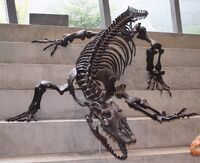
Megalania was a giant, carnivorous goanna that might have grown to as long as 7 meters, and weighed up to 1,940 kilograms.[9]
The more primitive synapsids, the pelycosaurs had been a dominant group during the Paleozoic and gave rise to the more mammal-like therpasids in the mid Permian. The Therpasids came under increasing pressure from the archosaurs the early Mesozoic, the first mammals being the only survivors of the line by late Jurassic.
Demise of the dinosaurs[]
The close of the Cretaceous saw the demise of the Mesozoic reptilian megafauna (see the Cretaceous–Tertiary extinction event). Of the large marine reptiles, only the sea turtles are left, and of the dinosaurs, only the small feathered theropds survived in the form of birds. The major surviving reptilian line is the lepidosaurs, of which the snakes are currently the most numerous and widespread representatives. The end of the "Age of Reptiles", opened up for the "Age of Mammals". Despite this, reptiles are still a major fauna component, particularly in tropical climates. There are about 8200 extant species of reptiles (whereof almost half are snakes), compared to 5400 species of mammals (of which 2/3 are rodents and bats). The most numerous modern group with reptilian roots are the birds, with over 9000 species.
Prehistoric reptiles[]
The term prehistoric reptile covers a broad category that is intended to help distinguish the dinosaurs from other prehistoric reptiles. As the dinosaurs, because of their long and successful reign for many millions of years, are almost exclusively dealt with in their own category of prehistoric life.
The category covers all the non-dinosaurian reptiles which are often erroneously considered to be dinosaurs, such as the sea faring varieties of plesiosaurs and the flying pterosaurs. Also included are ancient crocodiles such as Deinosuchus.
For information on the mammal-like "reptiles" (therapsids) and other amniotes often considered reptiles (including the well-known Dimetrodon), which are not part of the clade Sauropsida (with which "Reptilia" is generally synonymized), see Synapsid (amniotes related to mammals). For information on the ancestors of reptiles, traditionally classified as labyrinthodont amphibians, see Reptiliomorpha (reptile-like tetrapods).
References[]
- ^ a b Goodrich, E.S. (1916). "On the classification of the Reptilia". Proceedings of the Royal Society of London 89B: 261–276. doi:10.1098/rspb.1916.0012. Cite error: Invalid
<ref>tag; name "goodrich1916" defined multiple times with different content - ^ Watson, D.M.S. (1957). "On Millerosaurus and the early history of the sauropsid reptiles". Philosophical Transactions of the Royal Society of London, Series B, Biological Sciences 240 (673): 325–400. doi:10.1098/rstb.1957.0003.
- ^ Romer, A.S. (1933). Vertebrate Paleontology. University of Chicago Press. , 3rd ed., 1966.
- ^ Benton, Michael J. (2004). Vertebrate Paleontology (3rd ed.). Oxford: Blackwell Science Ltd.. ISBN 0632056371.
- ^ Romer, A.S. & T.S. Parsons. 1977. The Vertebrate Body. 5th ed. Saunders, Philadelphia. (6th ed. 1985)
- ^ Laurin, M.; Reisz, R. R. (1995). "A reevaluation of early amniote phylogeny". Zoological Journal of the Linnean Society 113: 165–223. (abstract)
- ^ Romer, A.S. & T.S. Parsons. 1977. The Vertebrate Body. 5th ed. Saunders, Philadelphia. (6th ed. 1985)
- ^ Colbert, E.H. & Morales, M. (2001): Colbert's Evolution of the Vertebrates: A History of the Backboned Animals Through Time. 4th edition. John Wiley & Sons, Inc, New York - ISBN 9780471384618.
- ^ (Molnar, 2004)
See also[]
- Animal
- Dinosaurs
- List of dinosaurs
- List of dinosaur classifications
- Prehistoric life